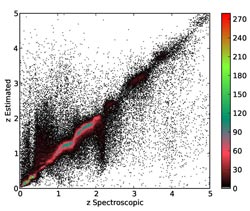Computer Science helps astronomers exploring the sky

Results of the new computational tool to determine the redshift of 130,000 quasars. They show the comparison between the actual redshift (x-axis) and calculations according to a model (y-axis).<br><br>Graphic: Polsterer / HITS<br>
The new junior research group “Astroinformatics” has recently commenced its activities at the Heidelberg Institute for Theoretical Studies (HITS). It will develop new approaches for analyzing and processing the continuously growing amount of data in astronomy, which is stored in various archives. Physicist and computer scientist Dr. Kai Polsterer leads the group. With this, HITS comprises a total of nine research groups.
“We focus on using new approaches to support observing scientists with their research,” says Kai Polsterer. The newly established junior group complements the activities of the research group “Theoretical Astrophysics”, led by Prof. Volker Springel,. which deals with computer simulations for galaxy formation and the role of dark matter. In the spring of 2014, yet another research group will be established and further strengthen the studies of Astrophysics at HITS. The focus of this research group will be on high-energy astrophysics.
In the past twenty years, computers have revolutionized astronomy. Due to new detectors and innovative telescopes, today’s astronomers can observe objects in unprecedented extend and with high resolution. Adding to this, there are new, untapped wavelength-regimes. Special “Survey Telescopes” map the sky and constantly collect data. Kai Polsterer wants to improve astronomers’ access to data that is available in archives in such a way as to promote a more intuitive research. As an example, he mentions the “Sloan Digital Sky Survey” which maps the sky with images in five wavelengths and detailed spectroscopy, and makes them digitally available. “There are many treasure chests full of data to be unearthed, but it is not easy for astronomers to actually browse the data, i.e. to do exploratory work,” the 37-year-old says. In a first step, he wants to develop tools that automatically extract object features from the data at hand, such as the so-called redshift. The redshift indicates how far away a galaxy is from us. A significant metrological effort is required in order to directly measure this distance. Therefore, the model-based, statistical values are very important for astronomers.
“The amount of data increases exponentially. The number of astronomers does not,” says Kai Polsterer. Methods of computer science can be of great help in dealing with this situation. For that reason, the new HITS group is working to increase the popularity of machine learning approaches in astronomy. Kai Polsterer is an expert in both areas: After having received his diploma in Computer Science from the Technical University of Dortmund, he earned his doctorate in Physics and Astronomy at the University of Bochum. Later on, he was head of software development in the project “Lucifer” at Bochum University. The Heidelberg State Observatory (Landessternwarte Heidelberg, LSW) and the Max Planck Institute for Astronomy (MPIA) are involved in this project as well. “Lucifer” is a combination of camera and spectrograph at the world’s largest optical telescope, the Large Binocular Telescope in Arizona. This instrument was built for studies in the near-infrared spectral range, which is invisible to the eye. Kai Polsterer will continue to work closely with the two Heidelberg facilities LSW and MPIA, as well as with the “German Astrophysical Virtual Observatory” led by Prof. Joachim Wambsganss (Heidelberg University).
Press contact:
Dr. Peter Saueressig
Public Relations
Heidelberg Institute for Theoretical Studies (HITS)
Phone: +49-6221-533245
Peter.saueressig@h-its.org
www.h-its.org
Twitter: @HITStudies
Scientific Contact:
Dr. Kai Polsterer
Junior Group leader
Astroinformatics
Heidelberg Institute for Theoretical Studies (HITS)
Phone: +49-6221-533245
kai.polsterer@h-its.org
www.h-its.org
Twitter: @AstroInformatix
Weitere Informationen:
http://www.h-its.org/english/press/pressreleases.php?we_objectID=1027
HITS press release
Media Contact
More Information:
http://www.h-its.orgAll latest news from the category: Information Technology
Here you can find a summary of innovations in the fields of information and data processing and up-to-date developments on IT equipment and hardware.
This area covers topics such as IT services, IT architectures, IT management and telecommunications.
Newest articles

Bringing bio-inspired robots to life
Nebraska researcher Eric Markvicka gets NSF CAREER Award to pursue manufacture of novel materials for soft robotics and stretchable electronics. Engineers are increasingly eager to develop robots that mimic the…

Bella moths use poison to attract mates
Scientists are closer to finding out how. Pyrrolizidine alkaloids are as bitter and toxic as they are hard to pronounce. They’re produced by several different types of plants and are…

AI tool creates ‘synthetic’ images of cells
…for enhanced microscopy analysis. Observing individual cells through microscopes can reveal a range of important cell biological phenomena that frequently play a role in human diseases, but the process of…





















